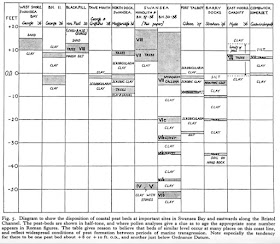When one does a bit of exploring, scores of different trails tend to open up before one........ there is a risk of information overload here, and others can explore the literature in much greater depth -- but one interesting point to be made is that there are abundant peat beds -- and traces of the "submerged forest" in many other coastal sites across South Wales.
FJ North, in his book "The Evolution of the Bristol Channel" (most recent edition, 1964) mentions
several occurrences, some based on the excavations for the building of docks at Barry, Cardiff, Swansea and Port Talbot. He has plenty of useful references too.
Much more recent is the unpublished theses by MP Lewis:
Lewis, M P, 1992, The Prehistory of Coastal Southwest Wales 7500 -3600 BP: an ... unpublished PhD thesis, Dept of Archaeology, University of Lampeter.
The most useful reference is this one, by Prof Harry Godwin, which is available on open access on the web:
https://nph.onlinelibrary.wiley.com/doi/pdf/10.1111/j.1469-8137.1940.tb07143.x
A Boreal transgression of the sea in Swansea Bay. Data for the study of Post-glacial history. VI.
by H Godwin - The New Phytologist, 1940 - JSTOR
The key info is as follows:
1. There are abundant fine-grained deposits extending down to c-55 ft (-17 m) below OD right round the South Wales coastline.
2. The deepest borehole record from Swansea reveals no less than six peaty /organic layers, each one underlain by clay. In the excavations for Barry Docks the deposits rested on an old land surface with soil and "weathered rock debris" at -40 ft (-12 m) OD. Above that there were 4 organic peaty layers interspersed with blue clays and silts. At the other sites some had multiple or alternating layers of peat and clay, and at some there were just some peat layers, all at or above OD.
3. Some of the interbedded clays are Scrobicularia clays (as at Port Talbot, Tawe mouth and Swansea North Dock) and others might be freshwater clays.
The bivalve Scrobicularia plana (peppery furrow shell) being dug out of a silty clay layer. This is a crucial "marine indicator for the layers associated with the submerged forest.
4. The peat beds apper to be in two horizons -- one between OD and -10 ft (-3 m), and the other between OD and +15 ft (+4.5 m). The latter (upper) bed is the one which has more abundant tree roots, branches and fallen trunks -- and this is the one which appears to correlate with the "submerged forest" which occurs between HWM and mid-tide level further west.
5. Pollen analyses of the peat beds show that the lowest ones are associated with pollen zones VIb and VIc (c 8,000 - 7,500 yrs BP) -- but the oldest peat beds (from zones IV and V) (10,000 - 8,500 yrs BP) are at about -50 ft (-15 m) in a Swansea Harbour borehole. The peats above OD which have associated tree debris appear to have formed in pollen zones VII and VIII (Atlantic and Sub Boreal, 7,500 - 2,500 yrs BP). Note that precise dates vary from place to place.
6. The peaty forest / submerged forest phase indicates forest growth on a land surface above OD but still well within the tidal zone, but with freshwater conditions. The growth of the forest spans the critical period in which a very rapid sea-level rise of c 1m per century suddenly slowed down.
7. Godwin, like all other authors, suggests that in order for this sequence of beds to have accumulated, there must have been a rapid marine transgression interspersed with periods of still stand or relative marine regression.
As far as dating is concerned, I am not aware of radiocarbon dates from any of these sites -- but the pollen evidence allows for quite straightforward correlation across Swansea Bay and Carmarthen Bay.
We are still not much further forward. How did these sea-level regressions occur at a time when global sea-level was rising rapidly and inexorably? Were there "pulses" or stillstands lasting for a few centuries that do not show up in the global sea-level record? How long does it take for a peat bed to form?
===========================




No comments:
Post a Comment
Please leave your message here